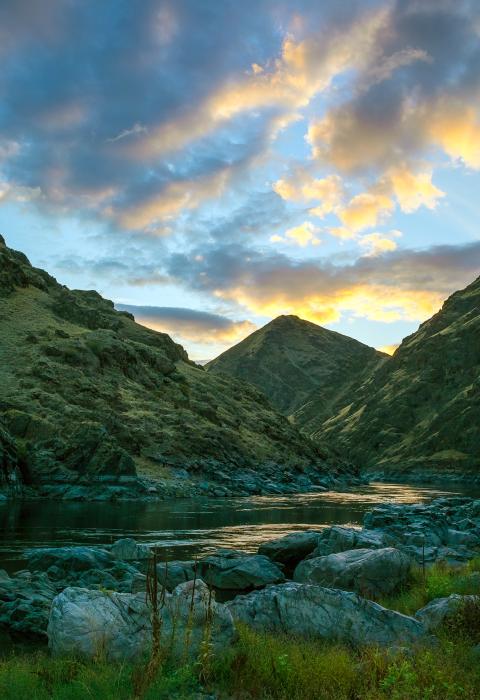Snake River
Idaho, Oregon
The Snake River likely got its name from the first European explorers who misinterpreted the sign made by the Shoshone people who identified themselves in sign language by moving the hand in a swimming motion. It appeared to these explorers to be a "snake,” but it actually signified that they lived near the river with many fish. In the 1950's, the name "Hells Canyon" was borrowed from Hells Canyon Creek, which enters the river near what is now Hells Canyon Dam.
The Hells Canyon area was once home to Shoshone and Nez Perce tribes. According to the Nez Perce tribe, Coyote dug the Snake River Canyon in a day to protect the people on the west side of the river from the Seven Devils, a band of evil spirits living in the mountain range to the east. In the late nineteenth century, the military drove the Native Americans out and settlers began ranching and mining in the canyon. Today, boaters explore archaeological sites and old homesteads, all part of the canyon's rich, colorful history.
Hells Canyon is one of the most imposing river gorges in the West. Until a million years ago, the Owyhee Mountains acted as a dam between the Snake River and its current confluence with the Columbia River, creating a vast lake in what is now southwestern Idaho. When the mountains were finally breached, the Snake roared northward, cutting a giant chasm through the volcanic rock.
Designated Reach
December 31, 1975. The segment from Hells Canyon Dam downstream to an eastward extension of the north boundary of section 1, T5N, R47E, Willamette meridian.
Outstandingly Remarkable Values
Botany
Few locations in the Pacific Northwest, or western North America, equal the Snake River Canyon in the concentration and number of rare or endemic plant species, including Macfarlane’s four-o'clock, bartonberry, prickly pear, and many vibrant wildflowers.
Culture
Rich prehistoric native American Nez Perce cultural remnants are found throughout canyon. The corridor contains one of the richest accumulations of riverine archeological resources in western North America. The interesting history of human habitation, mining, and ranching are interpreted and preserved at several national historic sites.
Ecology
The corridor contains wildlife that live in one of the most varied habitats in the nation. The habitat is so varied because of the extreme differences in elevation within a remarkably short distance—from 7,000 feet at Hat Point in Oregon, down to 1,500 feet on the Snake River, and back up to 9,393 feet in the Seven Devils Mountains in Idaho, all within a 10-mile horizontal distance. These differences in elevation allow varied plant communities to grow close together. Each plant community, in turn, provides a living space or habitat for its own family of wildlife. Throughout the year, there are about 350 species of wildlife that are part or fulltime residents of the area's habitats.
Fish
The Snake is known nationally for its abundant, unique, and diverse sport fishery including sturgeon, salmon, steelhead, rainbow trout and walleye. Hells Canyon is one of the last remaining strongholds of gigantic white sturgeon, sometimes topping 1,000 pounds.
Geology
The geology of the canyon provides research potential and portrays the complex geologic history of the canyon and western North America.
Recreation
The Snake River provides a unique blend of whitewater and boating opportunities. Hells Canyon is one of the best whitewater floating experiences in the Pacific Northwest, with a full range of float trip lengths and challenges. Fishing on the Snake is also popular for its variety of coldwater species, including white sturgeon, steelhead, and rainbow trout. Horseback riding and back country camping can be enjoyed in a favorable climate during the spring and fall, and many folks enjoy wildlife viewing across the varied terrain.
Scenery
Great contrasts of landform, vegetation, color, climate, and sound are evident in the corridor. The gorge is stunning—more than a mile deep and carved by eons of Snake River erosion.
Wildlife
A variety of wildlife call the canyon home including peregrine falcons, bald eagles, big horn sheep, mountain goats, large chukar flocks, black bears, mountain lions, and many other unique species.

